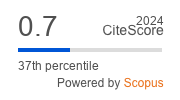Radiological Significance of Shear-Wave Elastography Technique for Evaluation of Solid Breast Masses with Histopathological Correlation
DOI:
https://doi.org/10.47723/kcmj.v19i3.1218Keywords:
elastography, histopathological correlation, breast massesAbstract
Background: Although various imaging modalities are available for evaluating suspicious breast lesions, ultrasound-based Shear-Wave Elastography (SWE) is an advanced, non-invasive technique complementary to grayscale sonography. This technique evaluates the elasticity of a specific tissue by applying sonic pressure to that tissue.
Objective: The aim is to assess the role of SWE in evaluating solid breast masses in correlation to histopathological study results.
Subjects and Methods: This prospective study was done in a tertiary care teaching hospital from September 2019 to August 2020. A study population of 50 women aged 18 years or above with an ultrasonographic (USG) diagnosis of solid breast masses was included.
Results: A significantly higher value of SWE elasticity ratio (E-mean) was observed in malignant tumors than in benign tumors (p <0.0001). The area-under-curve (AUC) for the BI-RADS 4 lesions was 0.522 (95% CI, 0.343-0.701) with an E-ratio cut-off score of 85.25, the sensitivity and specificity were 50% for diagnosing malignant tumors, whereas AUC for the HPE study was 1.000 (95% CI, 1.000-1.000) with an E-ratio cut-off score of 134.25; both the sensitivity and specificity were 100% for diagnosing malignant tumors.
Conclusions: Carcinoma breast is one of the most prevalent cancers globally. The most common benign tumor of the breast is a fibroadenoma, whereas Invasive Ductal Carcinoma is the most common malignant breast mass. A well-defined SWE elasticity ratio range might help predict the aggressiveness of breast tumors. SWE's correlation with BI-RADS in suspicious lesions adds to histopathology's advantage in distinguishing malignant tumors from benign ones.
Downloads
Published
Issue
Section
License
Copyright (c) 2023 AL-Kindy College Medical Journal

This work is licensed under a Creative Commons Attribution 4.0 International License.














